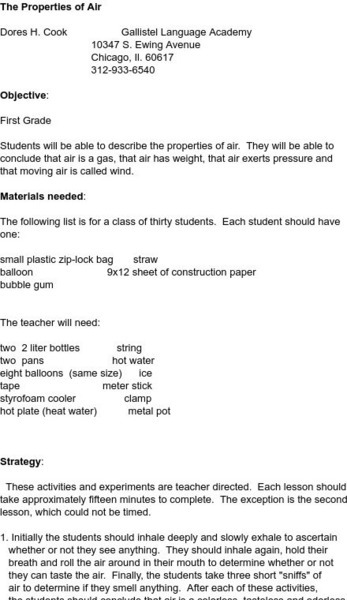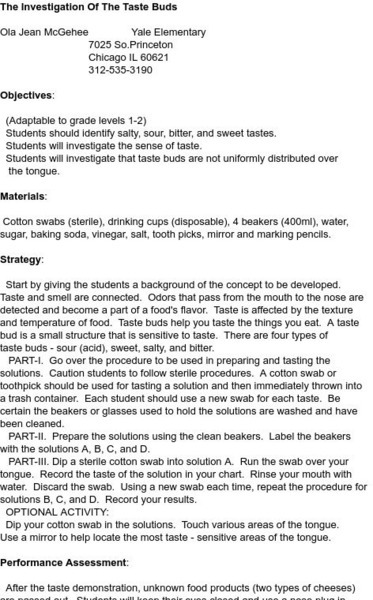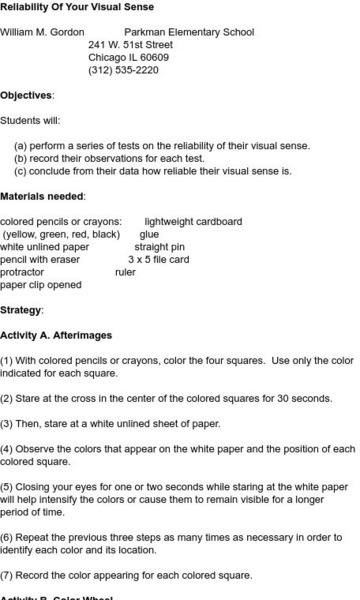Science and Mathematics Initiative for Learning Enhancement (SMILE)
Smile: Four Air Pressure Labs
Four lab exercises from the Illinois Institute of Technology demonstrating air pressure are given.
Science and Mathematics Initiative for Learning Enhancement (SMILE)
Smile: Electromagnets
This lesson plan contains several activities designed to help the student understand the magnetic effects of an electrical current.
Science and Mathematics Initiative for Learning Enhancement (SMILE)
Smile: Science Fair Information
A straightforward set of criteria for judging science fairs. No point system, just the criteria. Ideas to consider. Possibly too wordy.
Science and Mathematics Initiative for Learning Enhancement (SMILE)
Smile: Qualitative Coulomb's Law Lesson
A detailed lesson for helping learners to qualitatively experience the force versus distance relationship of Coulomb's law.
Science and Mathematics Initiative for Learning Enhancement (SMILE)
Smile: Mixture Problems
This site give a lesson plan on mixture problems. The lesson is a hands on learning experience for the students. Students mix yellow and red beads and determine the final percent of yellow and red beads in the mixture.
Science and Mathematics Initiative for Learning Enhancement (SMILE)
Smile: Real World Applications Work Problems
A lesson plan incorporating the use of real world work, rate, and time problems. Examples are provided and strategies for effective use of the lesson are included.
Science and Mathematics Initiative for Learning Enhancement (SMILE)
Smile: Acid Rain and How It Affects Our Environment
In this lesson plan the teacher uses sulfuric acid with stones, leaves, and raw fish to demonstrate the effects of acid rain on the environment. Young scholars create an environmental mural.
Science and Mathematics Initiative for Learning Enhancement (SMILE)
Smile: What's Covering You? And Why
This lesson plan features activities that investigate four functions of skin.
Science and Mathematics Initiative for Learning Enhancement (SMILE)
Smile: The Effects of Pesticides on the Food Chain
Lesson plan to construct and explain a food chain. Includes games and activities to teach and reinforce concepts.
Science and Mathematics Initiative for Learning Enhancement (SMILE)
Smile: The Properties of Air
Lesson plan to teach properties of air. Students use balloons, plastic bottles, plastic bags and a meter stick to conclude that air is a gas that has weight, exerts pressure, and moves.
Science and Mathematics Initiative for Learning Enhancement (SMILE)
Smile: The Tongue, a Sense of Taste
This lesson plan allows learners to investigate the four taste sensations and the receptors on the tongue.
Science and Mathematics Initiative for Learning Enhancement (SMILE)
Smile: The Investigation of the Taste Buds
This lesson plan allows students to taste sugar, baking soda, vinegar, and salt, which are then categorized as salty, sour, bitter, and sweet.
Science and Mathematics Initiative for Learning Enhancement (SMILE)
Smile: Reliability of Your Visual Sense
Lesson plan that investigates the sense of sight. Includes optical illusions which lead students to question the reliability of vision.
Science and Mathematics Initiative for Learning Enhancement (SMILE)
Smile: Teeth Identification in Omnivores, Herbivores and Carniv
For this lesson plan, students make puppets out of paper bags and use corn to give their animal (dinosaur, raccoon, etc.) the correct type of teeth based on the animal's diet.
Science and Mathematics Initiative for Learning Enhancement (SMILE)
Smile: Ears and Hearing
This lesson plan investigates sound waves and how the ear hears. Students create a model of the ear using a cardboard tube, plastic wrap, and a sheet of paper.
Science and Mathematics Initiative for Learning Enhancement (SMILE)
Smile: How Plants Spice Up Our Lives
Students take apart and label basic parts of a plant in this lesson plan. The students also use kitchen spices to determine which part of a plant was used for various flavorings.
Science and Mathematics Initiative for Learning Enhancement (SMILE)
Smile: Introduction to the Senses
This lesson plan allows learners to investigate body parts associated with each of the five senses.
Science and Mathematics Initiative for Learning Enhancement (SMILE)
Smile: Investigating the Structure of the Flower
This lesson plan has students make a model of a flower's structure using clay, toothpicks, and construction paper.
Science and Mathematics Initiative for Learning Enhancement (SMILE)
Smile: Structure of Seeds and Effects of Fertilizer on Plants
In this lesson plan, young scholars identify parts of seeds and the effect of fertilizer on their germination and development.
Science and Mathematics Initiative for Learning Enhancement (SMILE)
Smile: Light and Vision
Lesson plan should be used for intermediate students. Students work in pairs or groups to create a shoe box that will bend light.
Science and Mathematics Initiative for Learning Enhancement (SMILE)
Smile: Chemistry Is Crystal Clear
From the Science and Mathematics Initiative for Learning Enhancement (SMILE) program. A lesson plan analyze crystal samples and generalize about the six basic shapes of crystals. The formation of crystals is illustrated through various...
Science and Mathematics Initiative for Learning Enhancement (SMILE)
Smile: Metrics in the Home and in the Store
In this lesson plan site, young scholars will compare SI unit (metric) measurements of common household items and their English equivalents.
Science and Mathematics Initiative for Learning Enhancement (SMILE)
Smile: Popcorn Is a Gas
From the Science and Mathematics Initiative for Learning Enhancement (SMILE) program. A lesson plan in which students explore the pressure-temperature-volume relationships by performing a popcorn lab investigation. Intriguing. Great...
Science and Mathematics Initiative for Learning Enhancement (SMILE)
Smile: Relationships: Pressure, Volume, and Temperature
From the Science and Mathematics Initiative for Learning Enhancement (SMILE) program. A lesson plan that centers around a lab investigating the gas laws of Boyle, Charles, and Gay-Lussac. Data is collected, analyzed and discussed.

























